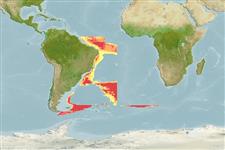Environment: milieu / climate zone / depth range / distribution range
Ecologia
marino batipelagico; distribuzione batimetrica 229 - ? m (Ref. 26282). Deep-water
Southwest Atlantic: off Amazon River mouth, northern Brazil.
Size / Peso / Age
Maturity: Lm ? range ? - ? cm
Max length : 7.5 cm SL maschio/sesso non determinato; (Ref. 37108)
Spine dorsali (totale) : 5; Raggi dorsali molli (totale) : 13; Spine anali: 2; Raggi anali molli: 9. Body slender. Head slightly longer than deep. Snout blunt and rounded. Back and sides light reddish brown, lower sides dark gray to black (Ref. 37108).
Minimum depth from Ref. 58018.
Life cycle and mating behavior
Maturities | Riproduzione | Spawnings | Egg(s) | Fecundities | Larve
Moore, J.A., 2003. Trachichthyidae.Slimeheads (roughies). p. 1184-1188. In K.E. Carpenter (ed.) FAO species identification guide for fishery purposes. The living marine resources of the Western Central Atlantic. Vol. 2: Bony fishes part 1 (Acipenseridae to Grammatidae). (Ref. 51171)
IUCN Red List Status (Ref. 130435)
Threat to humans
Harmless
Human uses
Pesca: di nessun interesse
Strumenti
Special reports
Download XML
Fonti Internet
Estimates based on models
Preferred temperature (Ref.
123201): 0.5 - 3.4, mean 1.8 °C (based on 167 cells).
Phylogenetic diversity index (Ref.
82804): PD
50 = 0.5039 [Uniqueness, from 0.5 = low to 2.0 = high].
Bayesian length-weight: a=0.01047 (0.00413 - 0.02653), b=3.03 (2.81 - 3.25), in cm total length, based on LWR estimates for this (Sub)family-body shape (Ref.
93245).
Trophic level (Ref.
69278): 4.2 ±0.73 se; based on food items.
Resilienza (Ref.
120179): Medio, tempo minimo di raddoppiamento della popolazione 1.4 - 4.4 anni (Preliminary K or Fecundity.).
Fishing Vulnerability (Ref.
59153): Low vulnerability (10 of 100).
